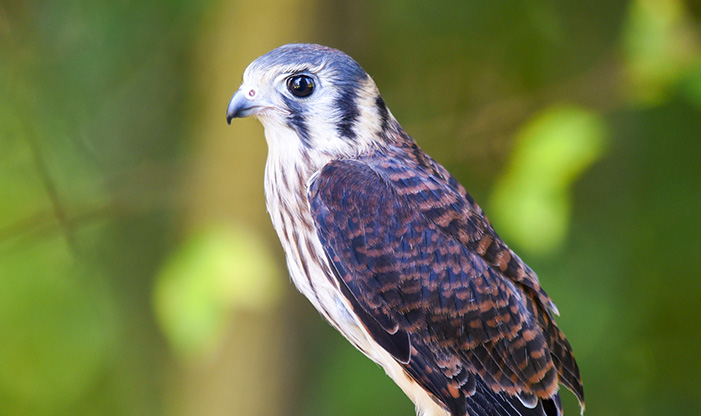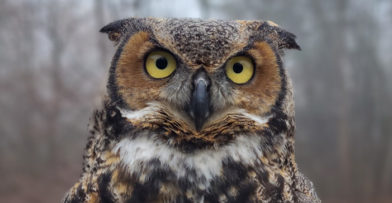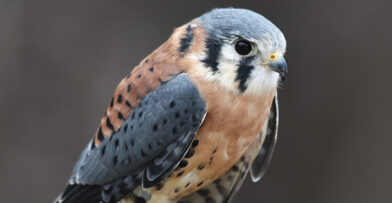Gracing the skies of grasslands and prairies, American Kestrels (Falco sparverius) are North America’s smallest of our six falcon species. Equipped with long and narrow wings, dark facial malar stripes, and a slender body frame, they are built for speed and agility in the air. There are a multitude of uniquities that make this species admirable, while concerns for their populations are on the rise.
Characteristics of American Kestrels
Although able to dive at speeds up to sixty miles per hour, these little raptors prefer to perch high above grasses to wait and pounce on their prey. They also have the ability to hover in the air, flapping their wings rapidly while staying stationary and looking for prey below. Their preferred diet consists of small rodents and large invertebrates, but they also have the ability to take other birds. Their name, Falco sparverius, means “falcon of the sparrows,” illuding to this occasional food item. Even so, many people refer to the kestrel as the “sparrow hawk.”
American Kestrels showcase a distinctive characteristic that most other raptors do not: sexual dichromatism. Males and females have different colors, allowing us to identify the different sexes. For example, male and female Red-tailed Hawks look the same. In kestrels, though, males wear blue wings while females have brown wings with black speckling. Their tails also have different patterns, with males having a large black terminal band on the ends of their tail feathers and females having consistent barring down their tail.
American Kestrel Behavior
In addition to their plumage, there are other physical and behavioral characteristics to help identify kestrels. Their heads are large, relative to their body size, and give their silhouette the appearance of wearing a helmet. They will also bob their heads and tails with great vigor when focusing on their surroundings. Frequently seen perched on telephone wires along roadsides, they can commonly be mistaken for mourning doves, but these attributes distinguish them for any birder.
Regionally, American Kestrel populations have been declining and conservation organizations are working on figuring out why. Kestrels are cavity nesters, and throughout Wisconsin, they use human made nest boxes placed in open grassland areas. This gives scientists access to study these residents: their diets, body mass, and clutch size can all be monitored to try to uncover what is affecting their populations. Both the loss of their required grassland habitat, as well as the common use of insecticides, may be negatively impacting the small falcon’s success in the wild.
Welcome Our New American Kestrel
The Schlitz Audubon Raptor Program recently welcomed a new female American Kestrel into our flock. Our new falcon hatched in early 2024 and, at only five months old, is already full grown. She has been gifted the name “Freyja,” a strong goddess from Norse mythology who symbolizes love, wealth, war, and magic.
Freyja hatched out in the wild, but strong storms came through the area when she and her nest mates were only a few weeks old. Winds broke their nest tree in half, leaving their cavity exposed in the stump of the tree that remained standing. Property owners discovered the nestlings, and, with good intentions, they took them inside to care for them. After a short while, they learned that the birds were falcons and sought out a local wildlife rehabilitator.
Even with the intention of helping animals, sick or injured wildlife should always go to trained and licensed professionals. There is a risk to human safety, and young animals can also become too habituated, or even imprinted, on their human caretakers. In this instance, young Freyja was exposed to humans and imprinted on them. Once she arrived at the wildlife rehabilitation center, the rehabber noticed her comfort around people and discovered that she was imprinted. Sadly, this is a permanent condition and birds like this cannot learn to live in the wild.
Kestrels and Our Raptor Program
Historically, our Raptor Program has cared for pairs of kestrels, both male and female. Saxon, our one-year-old male kestrel, joined us in 2023. Having both a male and female back in our program helps us teach about these amazing little birds and the unique attributes of their species.
Freyja and Saxon will be introduced at Xtreme Raptor Day on Saturday, November 2! Join us to meet them and our other educational raptors at this annual festival that engages and inspires visitors, while celebrating magnificent hunters of the sky!
We look forward to traveling throughout southeastern Wisconsin with our new female and male kestrels, teaching people about this amazing species and things that we can all do to help them in the wild! If you are interested in symbolically adopting either of our American Kestrels, please visit the Support Our Raptors section on our website.


